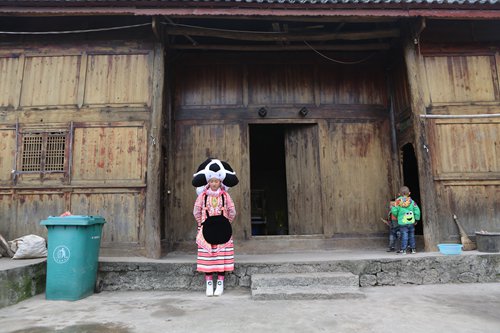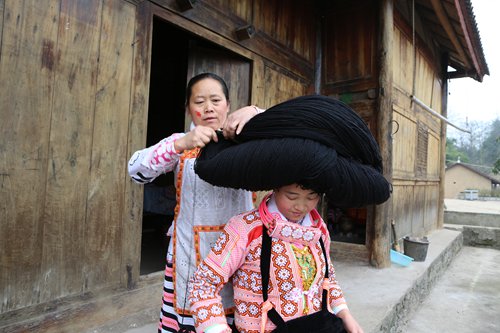
Yang Ermei wears a traditional Long-horn Miao headdress in the village of Suoga in Southwest China's Guizhou Province. (Photo: Chen Qingqing/GT)

Yang Ermei's mother-in-law helps Yang Ermei put on the headdress. (Photo: Chen Qingqing/GT)
Once a factory worker employed far away from her hometown, Yang Ermei, a 28-year-old woman belonging to the Long-horn Miao tribe in Guizhou Province, said that she had made the right decision to come back home.
"Now, I earn money by selling embroidered goods and sometimes participating in ethnic music and dance competitions," she said, describing her life in Suoga village.
A shy woman who kept her head lowered as she talked, Yang was wearing a giant horn-shaped headdress that covered her head like a huge umbrella.
Remembering the past
A branch of the Miao ethnic minority group, the Long-horn Miao (Changjiao Miao), or Qing Miao, are seen by outsiders as the most mysterious and isolated ethnic group in China. Living in the depths of a mountain forest in the western part of Southwest China's Guizhou Province, this small community consists of only 5,000 people in 12 tribes living throughout the counties of Liuzhi and Zhijin.
They do not have a written language, but use bamboo carvings, as well as sing songs and tell stories, to chronicle their history. Social activities, such as weddings, funerals, sacrifices and festivals, all take place outdoors.
The Miao people traditionally build their houses on the mountain slopes of their home region. Most houses are made out of wood with horn-shaped eaves that represent an ox, which the community respects for its strength.
For centuries the tribe has passed down its ancient culture and dress, the most unique and important being the huge horn-shaped headdresses such as the one Yang wore. Traditionally, they were made by wrapping the hair of their ancestors around a large comb shaped like a pair of horns.
"We were told that our ancestors wore this headdress to scare away wild beasts as they farmed in mountainous and remote areas, but now we only wear it during festival ceremonies," Yang told the Global Times on Friday.
Some of the traditional headdresses made from hair can weigh as much as four kilograms, "so we have replaced a large part of its with woolen yarn and only keep a lock of our ancestors' hair to commemorate them," Yang noted.
One recent ceremony was held during the Flower Dance Festival. Part of the tribe's Chinese New Year celebrations, the festival was held from January 28 to February 6 this year. Each day of the festival everyone gathers in the village square wearing traditional clothing.
"It's an occasion for young people to fall in love," Yang said, smiling.
Returning home
When she was 7 or 8 years old, Yang began learning embroidery as well as how to dye cloth.
"They're traditional skills that have been pass down through the generations and something every girl in the tribe cannot avoid learning," she said.
It takes at least a year to make an embroidered dress, which is then saved for special occasions.
"Embroidery helps me clear my head and concentrate, I could do it all day," she said.
Originally from a neighboring village, Yang married her husband, whom she has know since she was very young, five years ago.
For the Long-horn Miao community, family is a fundamental aspect of social life in the group. All 12 villages are bound together by numerous marriages.
After spending several years working in a factory in Jiaxing, East China's Zhejiang Province, Yang traveled the 1,900 kilometers back home in 2015 and opened a store to sell handicraft items at the entrance to the village. Occasionally, she works as a tour guide taking people around the village since she speaks Putonghua while most elderly people in the village only speak the local dialect.
"When I worked at the factory, I was with dozens of girls from our village," she said. "We brought needles, string and fabric with us and made embroidered items during our spare time."
Now, through her embroidery, tour guide work and ethnic music performances, she makes enough money to take care of her parents-in-law and two children.
In her store, some small-sized handicrafts sit on the shelves which range in price from 100 to 500 yuan ($15-$75). "Foreign tourists like our clothing, which can sell for around 2,000 yuan," Yang said.
However, young women in their 20s in the village are not interested in learning these traditional skills, which means they will likely be lost in the near future.
All hope is not lost, however.
"When my daughter grows up, I'll teach her how to produce finely dyed items," Yang said.
Living heritage
China's first ecomuseum was opened in this village in 1998 with the help of Norwegian museum professionals and local authorities, which ended up putting this small branch of the Miao ethnic group firmly in the public eye.
In recent years, about 20,000 visitors have visited the village during the Flower Dance Festival each year.
From time to time, Yang shares photos of her wearing a traditional headdress and clothing on WeChat.
"I travel occasionally to other cities to participate in competitions like embroidery. I want to do all I can to pass down our heritage," she said.
Yang is also doing what she can to preserve the tribe's music and dance. For example, the long three-holed xiao, a type of vertical bamboo flute, is a traditional instrument used to tell the tribe's stories.
"I am proud to say that I am among the handful of people in the village who knows how to play it," said Yang.


















































